Scout (train)
The Scout was one of the named passenger trains of the Atchison, Topeka and Santa Fe Railway. It started as train Nos. 1 (westbound) & 10 (eastbound) between Chicago, Illinois and Los Angeles, California. Inaugurated on January 16, 1916, this "budget" heavyweight train had tourist sleeping cars with upper and lower berths, "chair" cars (coaches) and an open-end observation car.
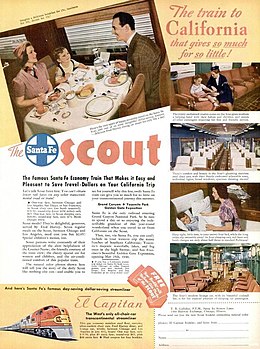 Ad in Life Magazine, April 1940 | |
| Overview | |
|---|---|
| Service type | Inter-city rail |
| Status | Discontinued |
| Locale | Western United States |
| First service | 1916 |
| Last service | 1948 |
| Former operator(s) | Atchison, Topeka, and Santa Fe Railway |
| Route | |
| Start | Chicago, Illinois |
| End | Los Angeles, California and Oakland, California |
| Service frequency | Daily |
| Train number(s) | 1 (westbound) 2 (eastbound) |
| On-board services | |
| Seating arrangements | Chair Cars (1946) |
| Sleeping arrangements | Sections, Double Bedrooms, Compartments, Drawing room Tourist sleeper (1946) |
| Catering facilities | Dining car |
| Observation facilities | Dormitory Lounge Car |
| Technical | |
| Track gauge | 1,435 mm (4 ft 8 1⁄2 in) |
The train was assigned Nos. 1 & 2 in 1920 and reverted to Nos. 1 & 10 a year later. In summer 1926 it left Chicago at 1115 and arrived Los Angeles at 0900 three days later, running via Ottawa Jct, Amarillo and Fullerton. In November 1939 it left at 2045 and arrived 0700, sixty hours on the same route except via Pasadena.
The Scout made its last run on June 7, 1948.
History
Timeline
- January 19, 1916: The Scout commences operation.
- 1920: The eastbound Scout is assigned No. 2, but becomes No. 10 the following year.
- January 4, 1931: The Scout is discontinued during the Great Depression. Thereafter, economy service was provided by the Hopi, the Missionary, and the Navajo.
- May 10, 1936: The "new" (renovated) Scout resumes. The westbound trip was completed in 60 hours, 15 minutes, while the eastbound schedule was reduced to 58 hours, 35 minutes.
- June 7, 1948: The Scout is withdrawn as passengers prefer to use Santa Fe's streamlined trains.
Major stations
.jpg)
Major stations on the main itinerary to Los Angeles Union Station:[1]
- Chicago, Illinois
- Kansas City, Missouri
- Wichita, Kansas
- Amarillo, Texas
- Clovis, New Mexico, point from which sections diverted to Carlsbad Caverns[2]
- Belen, New Mexico, a short distance south of Albuquerque
- Williams, Arizona, transfer point for bus connection to Grand Canyon[3]
- San Bernardino, California
- Pasadena
- Los Angeles
Oakland section major stations
.jpg)
West of Barstow, in eastern California, a second section departed northwest to the California Central Valley and Oakland:[4]
- Bakersfield
- Fresno
- Merced
- Stockton
- Richmond
- Berkeley
- Oakland
Gallery
- Postcard view of one of the train's club cars.
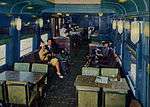 Sleeping car passenger lounge in 1941.
Sleeping car passenger lounge in 1941.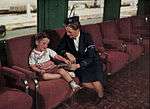 The courier-nurse assigned to the train.
The courier-nurse assigned to the train.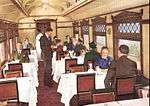 The dining car in 1937.
The dining car in 1937.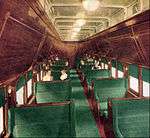 A sleeping car in day mode, 1937.
A sleeping car in day mode, 1937.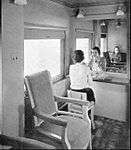 The train's Ladies' Lounge in 1937.
The train's Ladies' Lounge in 1937.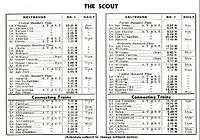 Schedule in 1941.
Schedule in 1941.
See also
- Passenger train service on the Atchison, Topeka and Santa Fe Railway
References
- "Santa Fe Railway, Tables 1, 4". Official Guide of the Railways. National Railway Publication Company. 78 (12). May 1946.
- "Santa Fe Railway, Tables P, 75". Official Guide of the Railways. National Railway Publication Company. 78 (12). May 1946.
- "Santa Fe Railway, Table 18". Official Guide of the Railways. National Railway Publication Company. 78 (12). May 1946.
- "Santa Fe Railway, Table 14". Official Guide of the Railways. National Railway Publication Company. 78 (12). May 1946.
- Duke, Donald (1997). Santa Fe: The Railroad Gateway to the American West, Volume Two. San Marino, CA: Golden West Books. ISBN 0-87095-110-6.
- Frailey, Fred W. (1974). A Quarter Century of Santa Fe Consists. RPC Publications, Godfrey, IL.
- Pelouze, Richard W. (1997). Trademarks of the Santa Fe Railway. The Santa Fe Railway Historical & Modeling Society, Inc., Highlands Ranch, CO.
- Strein, Robert; et al. (2001). Santa Fe: The Chief Way. New Mexico Magazine. ISBN 0-937206-71-7.
- Wayner, Robert J., ed. (1972). Car Names, Numbers and Consists. New York: Wayner Publications. OCLC 8848690.
- Zimmermann, Karl R. (1987). Santa Fe Streamliners: The Chiefs and their Tribesmen. New York: Quadrant Press. ISBN 0915276410. OCLC 19005401.
External links
| Wikimedia Commons has media related to Scout (train). |